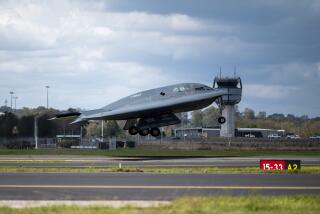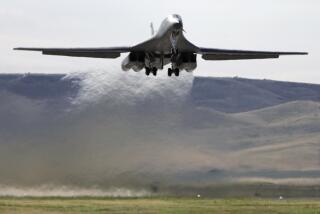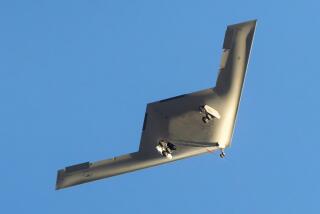AF Seeks to Save B-2, Cites Its Conventional War Uses
- Share via
WASHINGTON — Fresh from success and glory in the Persian Gulf War, the Air Force sought Wednesday to save the embattled B-2 Stealth bomber program by selling it harder than ever as an ideal weapon for waging conventional as well as nuclear warfare.
At the same time, Gen. George Lee Butler, testifying before the House Armed Services Committee, strongly denied rumors that the Air Force is offering to forgo fixing 96 of its trouble-prone B-1 bombers in exchange for authorization to build 75 of the radar-eluding B-2s.
Butler, head of the Strategic Air Command, said the B-1 is flying again after being grounded throughout the Gulf War with engine problems. He said the Air Force “is dedicated” to fixing other problems with the plane’s engine and its de-icing and anti-radar systems. The cost is estimated at $300 million to $1 billion.
But the general’s primary mission before the House committee was to build political support for the B-2, whose production was nearly halted by Congress at 15 planes last year on grounds that it is too expensive in the face of a reduced Soviet threat. About $26.7 billion has been sunk into the program, and an estimated $36.1 billion in additional funds is needed to build the remaining 60 planes sought by the Air Force.
Butler said the stunning performance of the F-117 Stealth fighter-bomber in the Gulf War demonstrated that the B-2, originally intended as a deep penetrating bomber in a nuclear war, could be devastating in a conventional conflict as well.
The B-2 “would have allowed the bombing (in Operation Desert Storm) to be done more effectively with less risk to crew and aircraft,” he said in asserting the B-2’s superiority to the F-117 and the aging B-52 bomber.
However, Butler ran into heavy flak from key members of the House panel, raising doubts about whether the military’s war successes can be converted into more than a token B-2 force.
“You guys are hurt by continually changing the rationale for this weapon,” said Chairman Les Aspin (D-Wis.), who turned against the B-2 last year. “Today, there’s a broad new focus on conventional which we’ve never heard before.”
Rep. William L. (Bill) Dickinson (R-Ala.), the panel’s ranking Republican and a B-2 advocate, warned that the Air Force probably would get no more than 36 of the bombers, a sharp cut from the 75 it wants.
When asked how being limited to 36 planes--about one Air Force wing--would change the B-2’s mission, a shaken Butler said: “I haven’t thought about it in those terms.”
“It’s about time to think about it,” Dickinson snapped.
A few moments later, the general suggested that 36 B-2s would be “an extraordinary force, nonetheless.” But later he said that, without 75 planes, it would be difficult to commit B-2s to a conventional war while keeping a sufficient number on alert to respond to a strategic nuclear attack.
A House Democrat who is one of the B-2’s leading advocates said in an interview that President Bush “can get the B-2 if he puts the heat on . . . Congress.”
The lawmaker, who requested anonymity, explained that “my Democratic friends who didn’t vote for Desert Storm--one of which was myself--are going to be looking for ways to strengthen their defense credentials between now and the 1992 election. If the President puts this on the line, these guys are going to run for cover (and support the B-2), in my judgment.”
More to Read
Sign up for Essential California
The most important California stories and recommendations in your inbox every morning.
You may occasionally receive promotional content from the Los Angeles Times.










